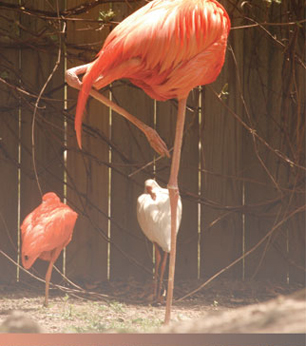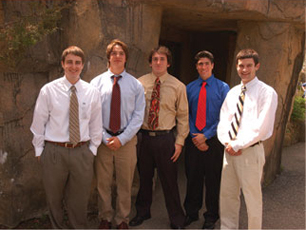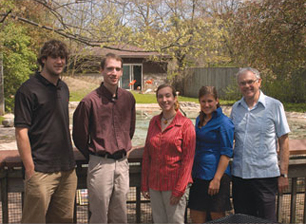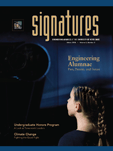

Left
to right: After presenting their plans for a new American River
Otter exhibit to zoo officials, Dalton Shaughnessy, Daniel
Scolaro, Josef Pappas, Manuel Nuno, and Colin
Roach pose for a team photo.

Left
to right: Peter Courtney, Nathan Boudreau, Claire Laurentius,
Charlotte Low, and Lloyd H. Ketchum Jr. stand
at the back of the current flamingo exhibit at the Potawatomi Zoo.
It borders the patio of the zoo’s refreshment stand, a very
busy location.
|
Although
its inhabitants are real animals, a zoo is like a city, with many
of the same needs. “When you think about it,” says Lloyd
H. Ketchum Jr., associate professor emeritus of civil
engineering and geological sciences, “a zoo, with its roads,
bridges, and other built environments, offers many of the same
engineering challenges as a cityscape. It’s a great place
for our students to exercise their skills, while helping a community
organization.”
Students in the Department of Civil Engineering and Geological Sciences have
been “engineering” at South Bend’s Potawatomi Zoo since 2004.
As in other years, this past semester two student teams focused on specific needs.
One team prepared a preliminary plan for a proposed American River Otter exhibit,
and one developed plans for an expansion of the flamingo exhibit.
Just as with any project they will encounter in the human world, the student
engineers needed to pay close attention to the inhabitants, the creatures that
will live in the environment they are creating. This means they had to research
the animals, talk to zookeepers, and study the guidelines for animal care set
forth by the Association of Zoos and Aquariums. They also visited other zoos
that house the same animals.
According to Terry DeRosa, director of the zoo, whether there
are two birds or 20, flamingos act with one mind. They don’t mix well with
other birds. They like their space open and airy, and they don’t particularly
care to have humans around. Add this to the fact that, like most zoos, Potawatomi
is on a limited budget, and students find that the simpler and more flexible
their solutions are, the better. In other words, they have to be very creative.
The students’ suggestions included the addition of a circular pump in the
wading pool to make it self-cleaning and decrease the number of times zookeepers
have to enter the exhibit. They also suggested installing mirrors, re-positioning
the zookeeper’s entrance, and evicting the other birds currently sharing
the space. After reviewing bids from professional contractors and obtaining additional
funding, the zoo hopes to be able to implement the students’ designs.
Ketchum is the faculty adviser for the Civil Engineering Service Projects program.
For information on the different projects, visit www.nd.edu/~cegeos/Service/Local.htm. |





